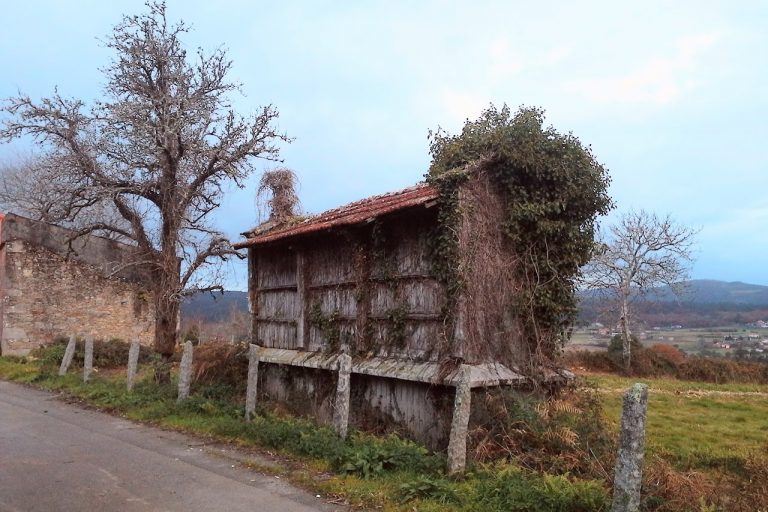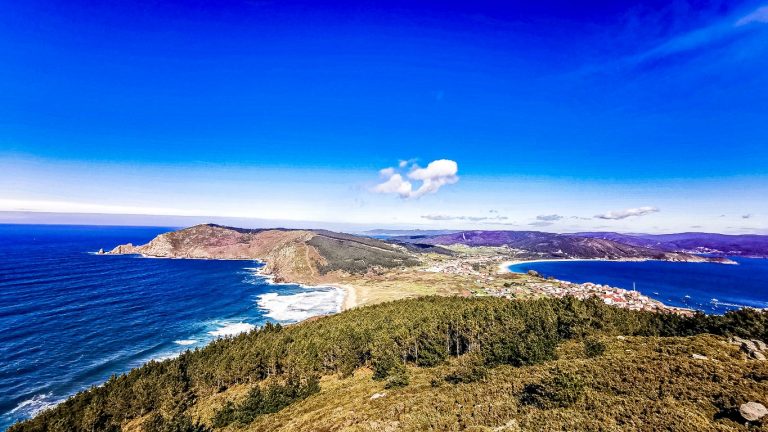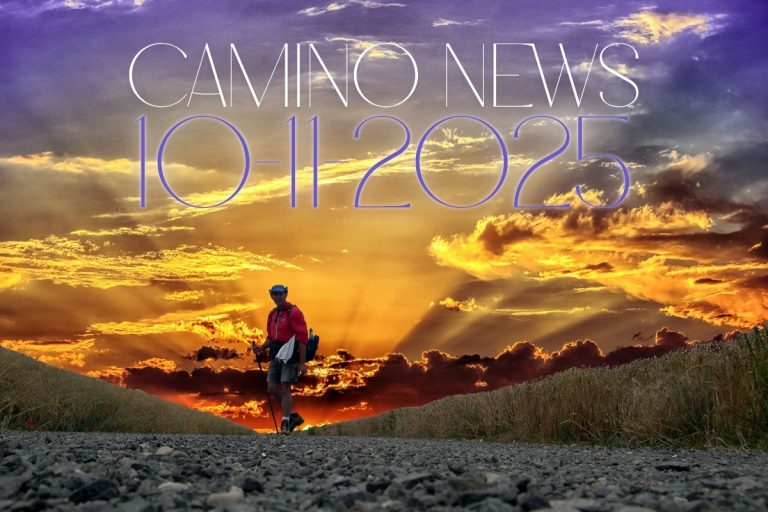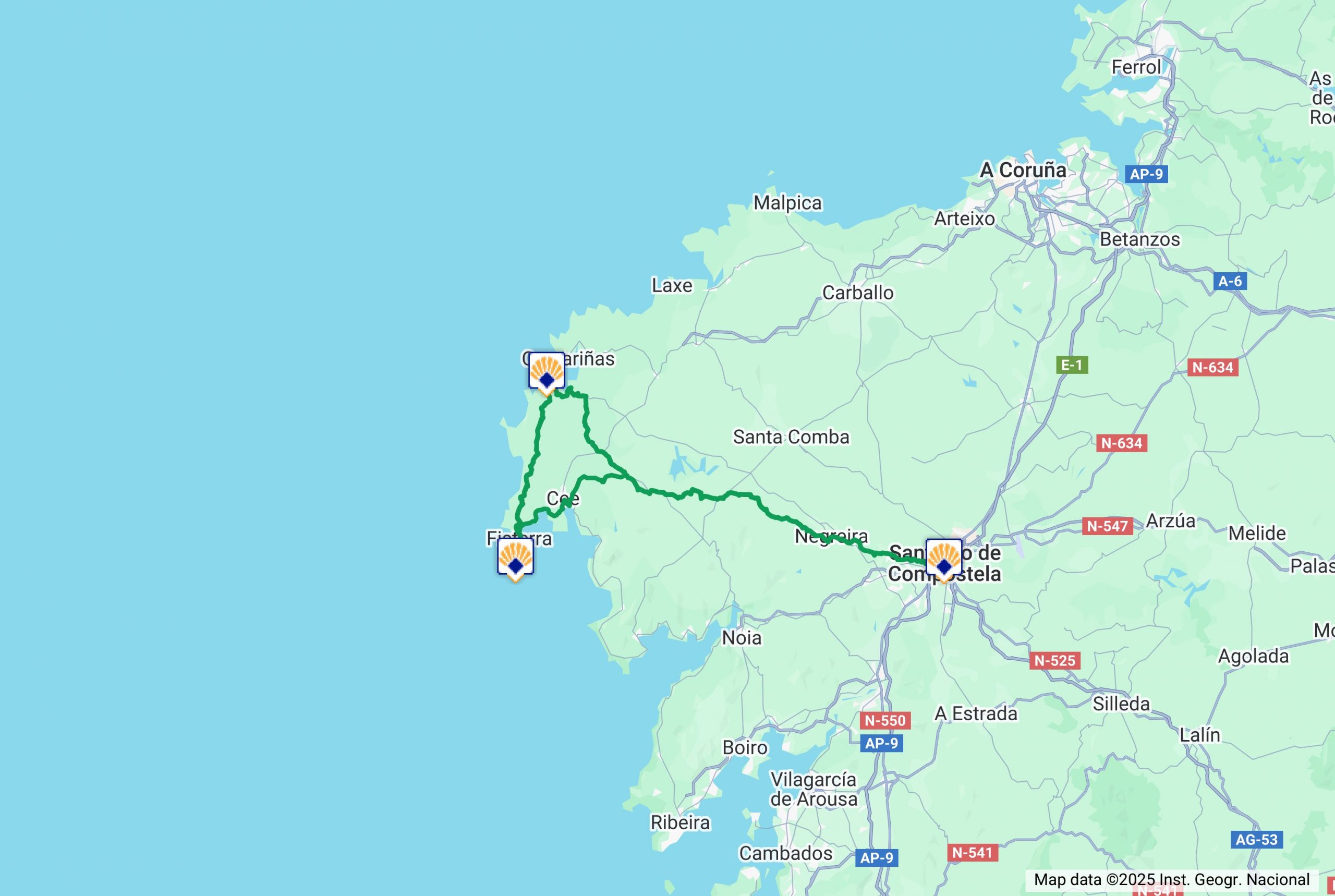
From the End of the World to the Sanctuary by the Sea – and homeward to Santiago
Introduction – The first encounter with this Camino
Dawn in Santiago de Compostela. The cathedral bells echo across the rooftops; pilgrims gather in the Praza do Obradoiro — some relieved, others with tears in their eyes. Yet for some, this is not the end but the start of a new chapter: the road westward, to the place where land gives way to sea. The Camino Fisterra – Muxía is a unique pilgrimage route, for it does not lead to the cathedral, but away from it. It offers pilgrims the chance to set out once more after days or weeks of arrival — toward the cliffs of Fisterra, the Marian sanctuary of Muxía, and finally back to Santiago’s heart.
Those who follow this loop walk through forests, villages, and valleys until they hear the murmur of the Atlantic. It is a journey of reflection, release, and renewal. This Camino stands apart from all others: shorter, more intimate, and filled with emotion. For beginners, it offers a gentle introduction; for seasoned pilgrims, a deep continuation. Whoever walks it feels the power of the ocean, the peace of the Galician countryside, and the rare joy of a double arrival in Santiago.
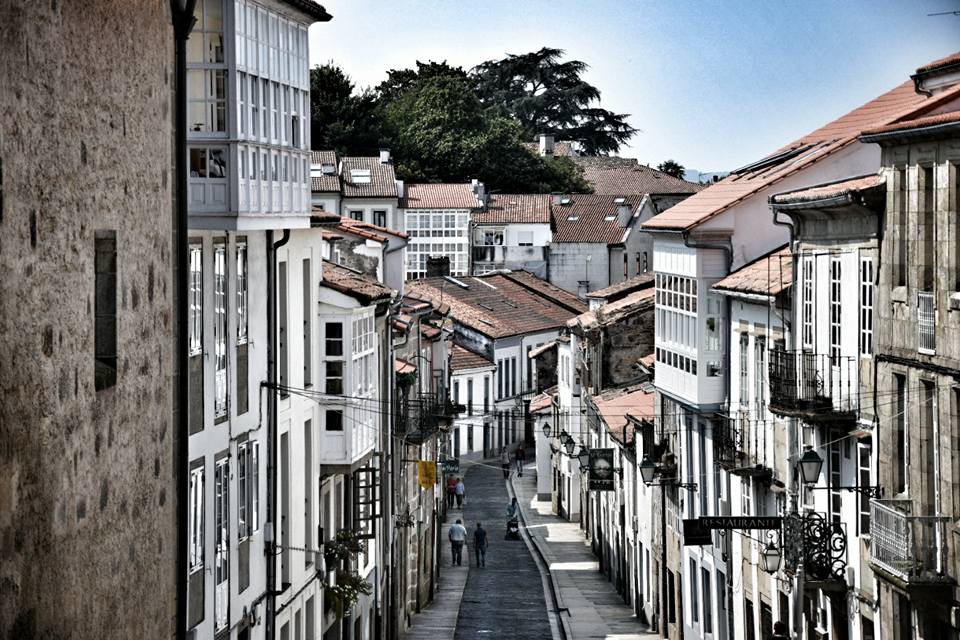
The Camino Fisterra: The Road to the End of the World
They say that those who reach Santiago have arrived at their goal. Yet some feel that something still calls — quieter, but more insistent. Beyond the cathedral, past the incense and the bells, another path begins. It does not lead to Santiago, but away from it, ever westward, to where the wind tastes of salt and the sea rinses the last thoughts from your pockets.
The Camino Fisterra is the echo of all the ways that came before. It stretches for about ninety kilometers to Cape Fisterra, the legendary “End of the World.” Those who continue on to Muxía extend their journey by a few days — not out of duty, but out of longing. Some walk the path in three or four days; others let themselves drift, staying longer in a village to breathe in the quiet of Galicia. This Camino cannot be rushed.
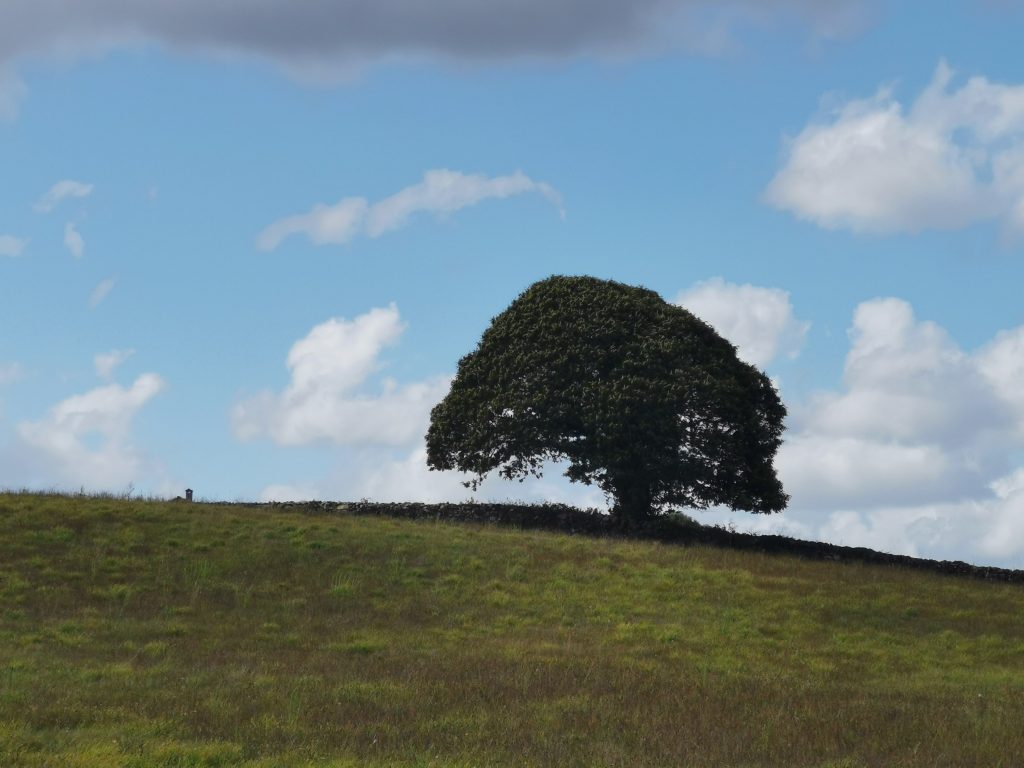
A Path Through the Heart of Galicia
Here, the pilgrimage changes. The broad roads and crowds of the Camino Francés lie behind. Instead, you are accompanied by the rustle of eucalyptus leaves, the distant ringing of a cowbell, the ticking of your own footsteps on damp paths. The landscape is both gentle and wild — hills, forests, mist. Small hamlets nestle among chestnut trees, and old grain stores stand like witnesses of a time unwilling to fade. Sometimes the path is paved, sometimes just earth — but it is always honest. Those who walk it feel their thoughts quiet down. Each climb and descent brings you closer to the sea — and to something you cannot quite name. And then, one day, the view opens before you: the Atlantic, endless, unwavering, beyond words.
The Magic of Fisterra
At the end of this path stands the lighthouse of Fisterra, the Faro. On the cliffs, where the wind pulls at your jacket and the spray salts your skin, many things end — and some begin. Here, the elders say, the sun sinks into the sea, and the souls of the dead travel westward. For the Romans, this was the Finis Terrae, the end of the world. For pilgrims, it is the opposite: a place of cleansing, of quiet rebirth. Once, they burned their clothes here — a ritual of release. Today, a pilgrim leaves behind a stone, a piece of memory, perhaps an old fear. And as the sun sets into the ocean, it becomes clear: there are paths that go beyond Santiago, leading to where silence speaks louder than words.



When the Wind Is at Its Kindest
The Camino Fisterra is at its most beautiful in spring or autumn, when the greenery is fresh or the light turns golden. Summer brings long days and the scent of salt — but also heat. Winter is possible too: rough, solitary, with rain that continues falling inside one’s thoughts. Yet those who walk it then experience Galicia as it truly is — honest, wild, unfiltered.
Solitude and Encounter
There are days when you meet almost no one. The wind becomes your companion, the rustling of leaves your reply. Then again, in a hostel, you might meet other pilgrims — quiet, tired, bound together by a shared silence. On this path, community forms without the need for words. Unlike the great routes, the Camino Fisterra has its own rhythm: slower, deeper, almost meditative. You don’t walk to arrive; you walk to remain — in the moment, in the breath, in the space between.
An Ending That Isn’t One
For many, Cape Fisterra marks the fitting close of their pilgrimage. For others, it is where something new begins. Some continue on to Muxía, to the Sanctuary of the Virxe da Barca, where legend tells that Mary appeared in a stone boat to comfort the Apostle James. There, between sea and rock, where the waves strike against the sanctuary, one may find what was still missing in Santiago: peace — or at least the courage to move forward without an answer. The Camino Fisterra is no epilogue. It is the echo of a journey that resonates inward. A quiet call toward the sea that whispers: “You’re not finished — but you have arrived.”




Connection Fisterra – Lires – Muxía: A Path Between Sky and Sea
There are paths that lead to a goal — and others that are the goal. The route between Fisterra and Muxía, passing through the silent village of Lires, belongs to the latter. It links two places that mirror each other: Fisterra, the world’s end, and Muxía, where the ocean meets the rocks and legends breathe. Whoever walks this stretch feels it immediately — shorter, yes, only twenty-eight kilometers, yet rich in subtle tones that reveal themselves only when you walk slowly. It is not a path to conquer, but to experience.
The trail begins in Fisterra, at the lighthouse, where many pilgrims take one last look over the sea. Here, direction itself dissolves — the West has been reached, and yet something still calls. Those who set out now walk not toward the Apostle’s tomb, but into their own quiet. The first kilometers climb over green hills, through small hamlets where roosters crow and the sea shimmers beyond the trees. The wind comes from the Atlantic, carrying salt on the skin and clarity to the mind. There are rises and dips, wet earth after rain, sand crunching underfoot — nothing threatening, but everything alive.
About halfway lies Lires, a place that feels like a breath. Whoever stays here finds more than shelter. Between white houses, gardens of hydrangeas, and the tiny beach where evening light dances golden on the waves, one understands what pilgrimage means beyond walking. Lires is not a pause — it is a space in between, where body and soul fall into the same rhythm. From there, the path continues through fields and woods, always within sight of the sea, never far. The final kilometers to Muxía grow quieter. You hear the surf long before you see it. And then, suddenly, it appears: the church of the Virxe da Barca, solitary and steadfast upon the rocks above the water.
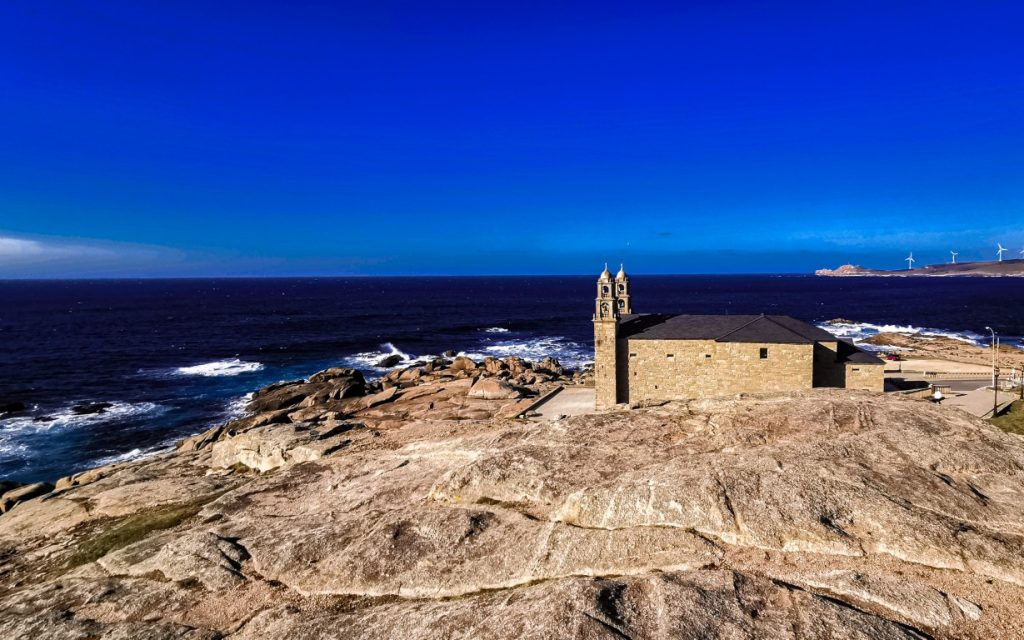
The Magic of Muxía
Muxía is a place where myths breathe. Here, according to legend, the Virgin Mary appeared in a stone boat to comfort the Apostle James. The rocks washed by the sea bear her name: the Pedra de Abalar, which moves when touched, and the Pedra dos Cadrís, through which one crawls to seek healing. Muxía is quieter than Fisterra, less known, but no less profound. While in Fisterra fire symbolically burns away the old, here it is the waves that carry off what is no longer needed. Some pilgrims say Muxía is the heart that keeps beating after the last step.
In the evening, when the light breaks across the granite rocks and gulls circle above the sea, one understands that this is not a place of ending, but of transformation.
When the World Is at Its Most Silent
The path can be walked year-round, but spring and autumn bring its gentlest mood — blooming meadows, clear air, the sea shifting through its colors. In summer, salt rests on the skin, the sun burns, yet the wind stays kind. In winter, when storms sweep along the coast, the trail becomes something else — rough, empty, haunting. Then the Atlantic speaks louder, and those who walk can hear what they might otherwise have missed.
A Path for the Soul
This connection between Fisterra and Muxía is more than a route. It is a bridge between two states of being — between letting go and rediscovery. Fisterra is the dramatic finale, the point where many weep. Muxía is the gentle echo that lingers after the tears have dried. Some pilgrims come here to continue walking; others, to finally stop. Both find what they need. For this path reminds us that the sea does not merely begin beyond the land — it continues within us. And when one stands at the edge of the rocks, watching the surf, one could swear it whispers: “Go on. Or stay. But never forget this moment.”




The Camino to Muxía – A Path Between Legends and the Untamed Sea
Sometimes a path does not end where you arrive. The Camino Muxía is such a path — quiet, inward, a continuation of pilgrimage beyond the cathedral of Santiago. It begins where many believe their journey is complete: on the Praza do Obradoiro, before the stone towers, under the sound of bells that speak of homecoming and yet echo in some ears as a call to go on. For those who hear that call, the way continues — to the place where the land runs out and the sea begins. To Muxía it is about 87 kilometers: three to four days if you wish, or an eternity if you truly walk it.
Those who set out on the Camino Muxía do not enter foreign land, but the innermost heart of Galicia. The path leads through soft hills and quiet villages, past old stone walls and along tracks that steam in the morning mist. The scent of damp wood mingles with eucalyptus and the distant salt of the ocean. At times the forest itself seems to breathe, and every step echoes as though one were finding their way back to an ancient rhythm.
Beyond Negreira, where many pilgrims rest for the first time, the landscape grows more primal. Hórreos stand as silent witnesses — those narrow stone granaries that once protected the harvest from moisture and speak of a time when nothing was wasted. Between fields, meadows, and streams, one loses the sense of distance. Only the wind remains faithful. The farther west you walk, the more present the sea becomes — first in scent, then in wind, finally in light. And one morning, after days of walking, it appears before you: the sea, vast, silver, untamed. And beyond it, Muxía, rising on the rocks where heaven and earth seem to meet.
Muxía is more than a place. It is a thought made of stone, water, and prayer. Here, on the Costa da Morte, where the Atlantic beats endlessly against the granite cliffs, stands the church of the Virxe da Barca. It seems to have risen from the waves themselves — simple, steadfast, and full of stories. The legend tells that the Virgin Mary appeared here in a stone boat to encourage the Apostle James when his strength was gone.
The remains of that boat — the sacred stones Pedra de Abalar and Pedra dos Cadrís — still lie here. It is said that the pure of heart can see the stone move, and that those who crawl beneath it leave illness and doubt behind. Muxía is quieter than Fisterra, gentler, almost like a prayer. While there the fire of cleansing burns, here it is the water that speaks — in endless motion, in unceasing rhythm. The waves strike the rocks as if to whisper to the pilgrims: “Not everything that ends is over.”
The Camino Muxía can be walked at any time of year, but it shows its most beautiful face in spring and autumn. Then the light carries a warmth unrelated to heat, and the sky paints the land in gold and blue. In summer the sun stands high, but the Atlantic wind softens its force. And in winter, when rain and storm sweep the coast, the true character of this path is revealed — wild, unbridled, honest. Those who walk then learn that beauty also lives in resistance.
Among all the Caminos, the Camino Muxía is one of the quietest. There are no crowds, no haste, no stage — only wind, stones, the sea, and oneself. You meet few pilgrims, and when you do, it is usually in brief, sincere moments: a nod, a shared glance, a silent understanding. This path is no showcase; it is a refuge. It belongs to those who understand walking as a language. Muxía is not a goal for everyone. But whoever arrives here takes something away that words cannot hold — perhaps only this gentle knowing: that some paths do not end, but continue in a constant breath — in the waves, in the wind, within us.
The Return to Santiago – Homecoming with Open Eyes
Standing in Fisterra or Muxía, one feels that the sea ends many things, but closes nothing completely. Most pilgrims set out again not with their bodies, but with their hearts — back to Santiago, on foot, just as their companions of old once did, before buses and timetables existed. These two or three days of return are not an appendix, but the final, often most meaningful stage. It is the moment when the silence of the Atlantic slowly yields to the sounds of villages, to human voices, to the rhythm of daily life. The Camino thus offers a gentle landing — a chance to let the lived experience settle before rejoining the accelerated world. Those who walk this way back no longer move toward a goal, but breathe through the path itself — each step a farewell, each glance a new beginning.
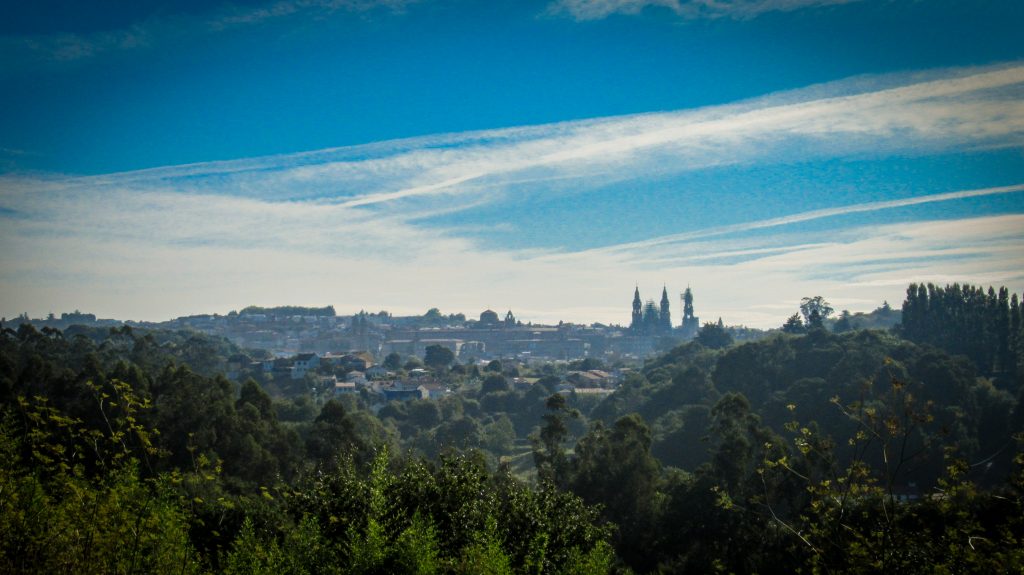
There is a particular strength in this return. It leads from the vastness of the ocean back to the heart of Galicia, through Olveiroa and Negreira, into familiar landscapes that now seem transformed because the pilgrim has changed. Some choose an even longer loop — the new Volta de Gloria, passing through Cee, Ézaro, O Pindo, Carnota, Muros, and Noia before reaching Negreira — to say one last “Adeus” to the Atlantic. Those leaving from Fisterra walk via Corcubión to Cee, where they turn one final time along the coast.
Pilgrims starting in Muxía take the path through Dumbría and, three kilometers beyond the junction, turn right instead of following the road to Olveiroa, descending toward Cee. There, the Paseo Marítimo runs along the harbor and beach, following the signs of the Volta de Gloria. This route is no escape from the end, but a conscious slowing down — a farewell in the rhythm of the waves. And when one finally stands again on the Praza do Obradoiro, in the golden light of the cathedral, one knows: the journey has not ended. It has simply changed direction — from outer motion to a quiet, inner continuation.


Historical background & cultural significance
The idea of going westward beyond Santiago reaches far back. Long before Christianity, Cape Fisterra was considered a mystical place – the Romans called it Finis Terrae, the end of the known world. Here, where the sun sinks into the ocean, people celebrated sun cults more than two thousand years ago.
With the discovery of the Apostle’s tomb in Santiago in the 9th century, the cathedral became the pilgrims’ goal. Yet many wished to continue – to the sea, to perform one last ritual of letting go. Burning clothes, laying down shells, or dipping one’s feet into the ocean are old traditions still kept alive by pilgrims today.
Muxía, in turn, is tied to the legend of the Apostle James: here the Virgin Mary is said to have appeared to him in a stone boat to encourage him. The place became an important Marian shrine that pilgrims continue to visit to this day.
Facts:
- First references: medieval accounts of pilgrims who continued “to the end of the world”
- Key historical places: Santiago, Fisterra, Muxía
- Important legends: apparition of the Virgin Mary in Muxía; sun cult at Cape Fisterra
- Significant monuments: Cathedral of Santiago, Lighthouse of Fisterra, Santuario da Virxe da Barca (Muxía)

Geography & landscapes
The route leads through the heart of Galicia: gentle hills, eucalyptus and chestnut forests, quiet river valleys. From Santiago to Olveiroa one crosses rural Galicia, where small hamlets, granaries (hórreos), and old bridges shape the landscape.
From Cee onward the view opens to the Atlantic – a moving moment, when after days inland the vastness of the ocean suddenly appears. The section to Fisterra follows the coast, passing coves and beaches. From there the path leads on to Lires, a quiet village between two bays, and finally to Muxía with its dramatic rocky coastline. The way back inland leads via Dumbría to Santiago, once more through forests, valleys, and quiet villages.
Facts:
- Elevation profile: gentle hills, no extreme climbs
- Types of landscapes: forests, river valleys, coastal regions, beaches, rocky shores
- Climate zones: Atlantic-maritime, mild temperatures, frequent rain
- Geological features: granite cliffs on the coast, slate inland
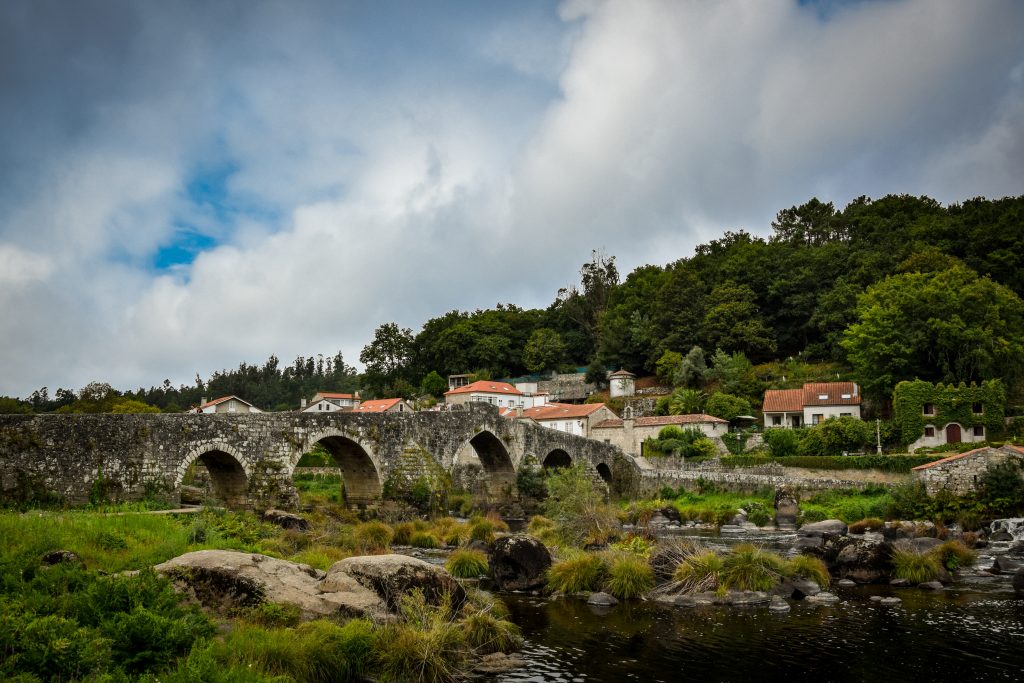
Length, duration & level of difficulty
The Camino Fisterra – Muxía covers about 190–200 km in 10 stages. It can be walked in 9–12 days, depending on breaks and fitness. Daily distances usually range between 15 and 33 km.
The path is not technically difficult – no extreme mountains, no dangerous passages – but it requires solid endurance. Especially the return from Muxía to Santiago brings longer stages. Mentally, it is a journey of reflection: pilgrims who believe they have already “arrived” continue once more – a special experience.
Facts:
- Total length: about 190–200 km
- Duration: 9–12 days
- Number of stages: 10
- Total elevation gain: moderate, about 3,500 m accumulated
- Level of difficulty: medium, well suited for beginners with basic fitness
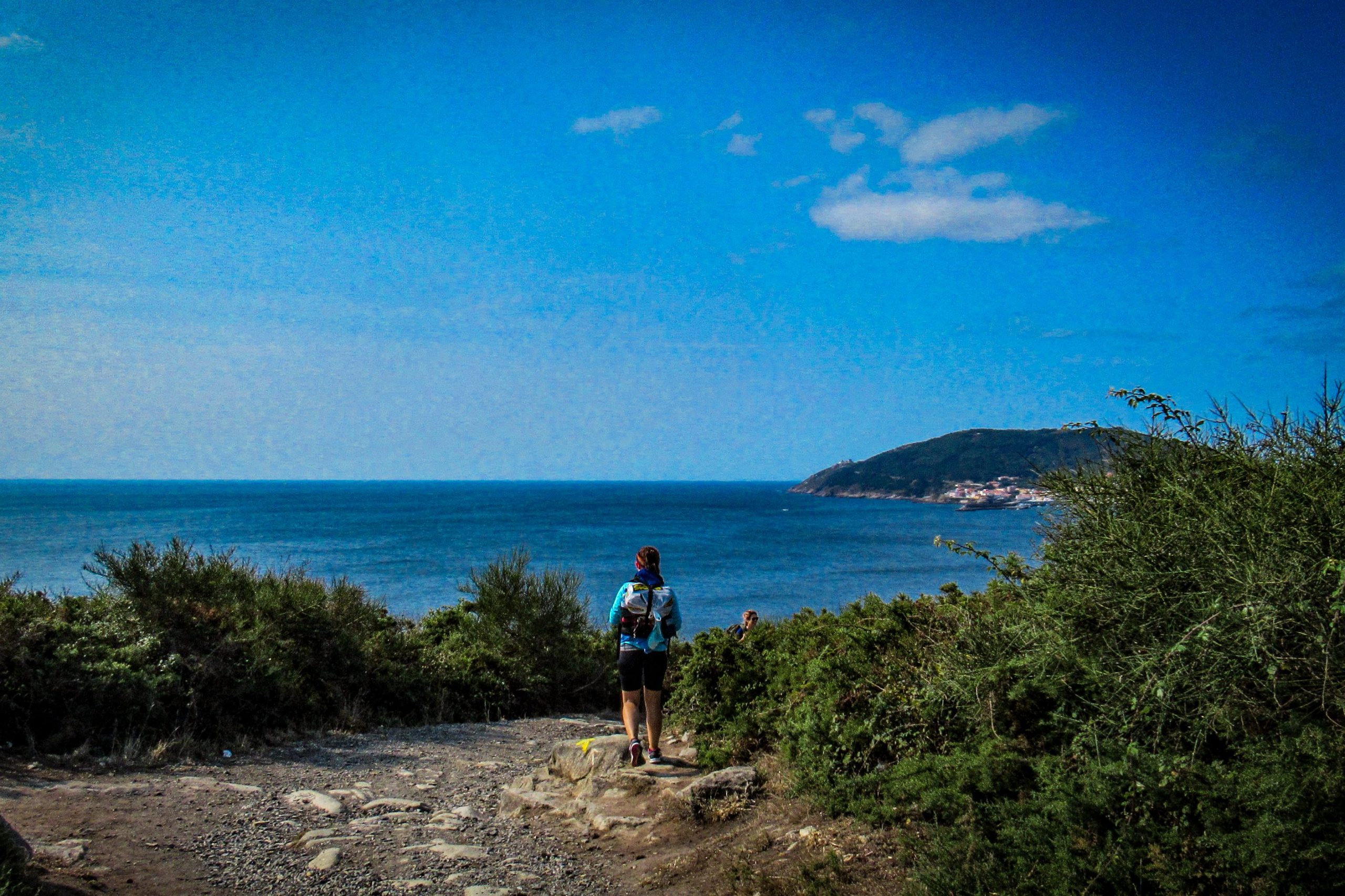
Pilgrim infrastructure
The infrastructure is solid, though not as dense as on the Camino Francés. In Santiago, Negreira, Olveiroa, Cee, Fisterra, and Muxía there are plenty of hostels and guesthouses. In smaller places such as Lires or Dumbría, private accommodation and guesthouses are available.
Grocery shops, bars, and restaurants are found regularly, though some stages (e.g. Negreira – Olveiroa) offer fewer options. Water is available often enough.
Facts:
- Types of accommodation: municipal hostels, private albergues, guesthouses, small hotels
- Water points: regular, especially in villages
- Seasonal dependence: limited service in winter, some hostels closed
- Reservation: recommended in summer, otherwise usually not necessary
Special sights & highlights along the way
- Santiago de Compostela: cathedral and Praza do Obradoiro
- Ponte Maceira: medieval bridge over the Tambre
- Cape Fisterra & lighthouse: the “end of the world,” sunset over the Atlantic
- Santuario da Virxe da Barca (Muxía): Marian shrine by the rocky sea
- Lires: quiet coastal village between two bays, ideal for pausing
Facts:
- Top 5 sights: Santiago, Ponte Maceira, Cape Fisterra, Santuario Muxía, beaches of Lires
- Top 3 culinary experiences: Pulpo a la Gallega, fresh fish on the coast, Queixo de Tetilla cheese
- Spiritual places: Cathedral of Santiago, Lighthouse of Fisterra, Santuario da Virxe da Barca
- Recommended photo spots: sunset at Cape Fisterra, coast near Muxía, bridge of Ponte Maceira

Best time to travel & climate tips
Spring and autumn are the most beautiful seasons: mild temperatures, fresh green or golden autumn light. Summer brings long days and beaches, but heat and crowded hostels can be challenging. Winter is harsh, often rainy, some accommodations are closed – yet it offers peace and solitude.
Facts:
- Best travel time: April–June, September–October
- Average temperatures: spring 10–18 °C, summer 18–25 °C, autumn 12–20 °C, winter 5–12 °C
- Weather risks: heavy rain in winter, occasional heat in summer valleys
Who is this Camino for?
This Camino is ideal for pilgrims wishing to extend or round off their way to Santiago. It suits beginners with normal fitness, spiritual seekers, and cultural travelers who want to experience Galicia’s coast. The sporty can walk it in fewer days, while those seeking leisure may take more time.
Facts:
- Beginner-friendly: yes, with basic fitness
- Required fitness: medium
- Particularly recommended for: reflective pilgrims, culture lovers, coastal enthusiasts
Recommendations & practical tips
- Take your time for the sunset in Fisterra – it is one of the most powerful experiences of the entire Camino.
- Spend a night in Lires – the small village between sea and river offers peace and contemplation.
- Enjoy the colors of the sunset in Muxía. In contrast to the emotional conclusion in Fisterra, here begins the colorful lightness of being.
- Plan the return from Muxía to Santiago well – the stages are longer, the infrastructure somewhat thinner.
- Carry cash, as card payment is not always possible. And often a minimum of 10 euros applies for card transactions.

Facts:
- Equipment: rain protection, broken-in shoes, light clothing
- Preparation: 2–4 weeks of daily walking practice is sufficient
- Arrival: Santiago is well connected by plane, train, or long-distance bus. For pilgrims who continue after completing their main Camino, walking is a wonderful option.
- Special features: certificates available – Compostela (Santiago), Fisterrana (Fisterra), Muxiana (Muxía)
Rituals at the End of the World
The Camino does not end in Santiago – many pilgrims continue to the sea. At Cape Fisterra and in Muxía, rituals have developed over time that bring the journey to a special close:
- Earlier: burning clothes or shoes
Traditionally, pilgrims burned parts of their clothing or their shoes at the lighthouse of Fisterra – as a symbol of purification and new beginnings. Today this ritual is forbidden (fire hazard, environmental protection). - Today: laying down a stone or throwing it into the sea
Many pilgrims bring a stone all the way to the cape. At the Faro of Fisterra they place it on the rocks or build small cairns, which mark their personal path.
Others continue to Muxía: in front of the church of Virxe da Barca, where the waves crash against the rocks, the stone is thrown into the sea or left among the rocks – a quiet yet powerful gesture of release. - Taking a shell
While the stone remains behind in Muxía, many pilgrims take a shell from the beach in Fisterra. It becomes a symbol of the homeward journey: not only a keepsake, but also a sign that the Camino, in some way, continues – in everyday life or perhaps on a future pilgrimage.
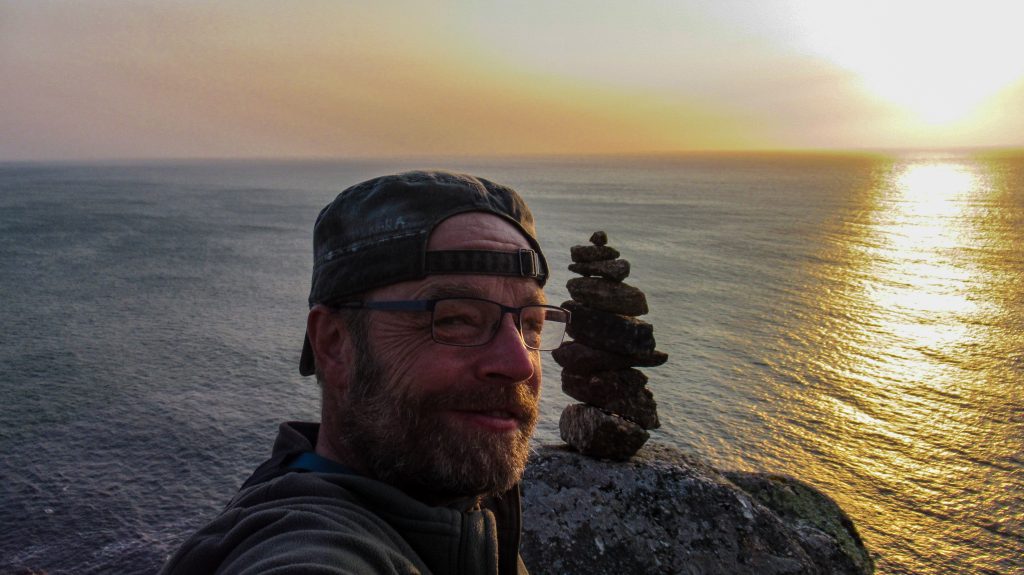
These rituals are not an obligation, but they invite pilgrims to consciously complete their way. And sometimes they spark the idea of returning on foot – a second Camino, not only to the sea, but back to the heart of Europe. Just as pilgrims once performed penance, the Camino today has also become a modern place for time out and new beginnings, offering the chance to step away from everyday life for several weeks in the form of a sabbatical.
In countries such as Germany, South Korea, or Switzerland, some companies offer this type of sabbatical to their employees – either to prevent burnout among specialists or to test leadership and endurance for potential higher positions. Another example are the “Veterans of the Camino” – an American association that offers war veterans a form of “resocialization” into civilian life and, above all, a way to better cope with their inner demons.
As an inspiring conclusion, just as for the Camino Francés, the following may apply:
“Pilgrim, go your way and let people talk.” – Dante Alighieri
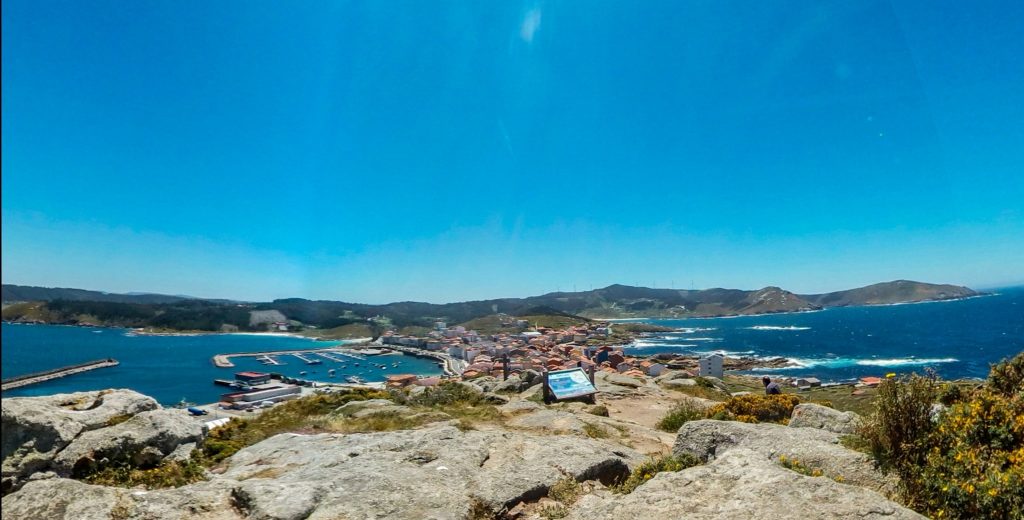
For one thing is certain: most people mean well, even when they offer their opinions – requested or not. Each pilgrim carries their own question, and this lies beyond the criticism of others. Conversation and exchange are not hindered by this. But whoever learns to receive the opinions or positions of others as neutral, rather than as personal attack, will have found great help in this simple quotation from Dante Alighieri’s Divine Comedy, written in the year 1300.
Reflection section by region
- Santiago – Negreira – Olveiroa: “What questions do you take with you when you leave Santiago in search of the sea?”
- Olveiroa – Cee – Fisterra: “What burden do you leave behind at Cape Fisterra?”
- Fisterra – Lires – Muxía: “What hope do you carry with you to the Marian shrine of Muxía?”
- Muxía – Santiago: “What answer do you find when, after days by the sea, you return to Santiago?”
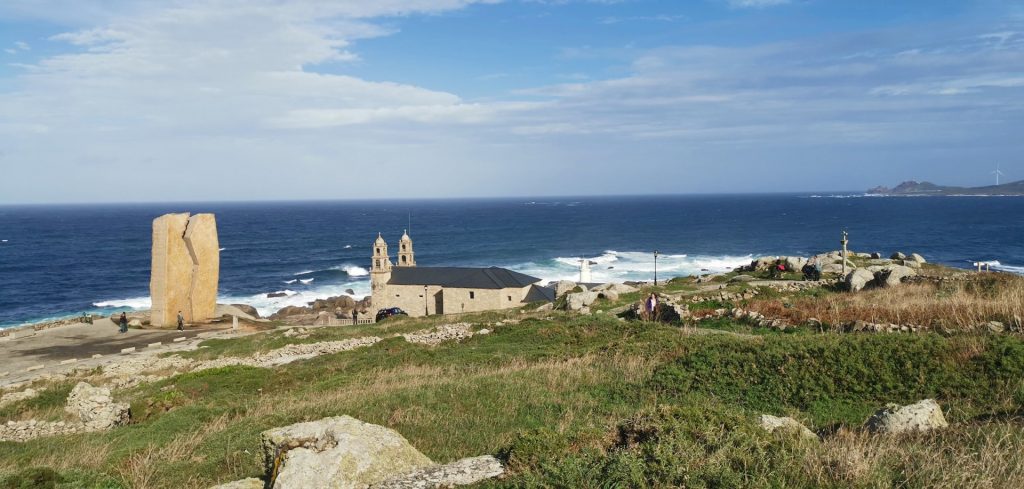
Camino of the Stars – Camino Fisterra – Muxía
Santiago de Compostela, Negreira, Vilaserío, Santa Mariña, Hospital, Olveiroa, Cee, Corcubión, Fisterra [here the Camino Fisterra ends at Cape Finisterre], Lires, Muxía [here the Camino Muxía ends at the Sanctuary of Virxe da Barca], Dumbría, Olveiroa [here the routes rejoin], Negreira, Santiago de Compostela
